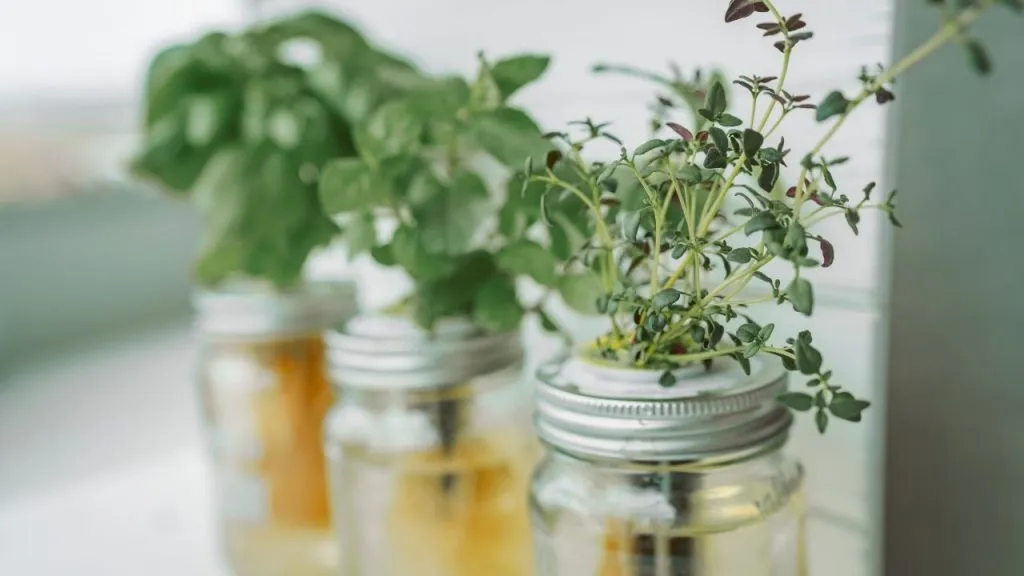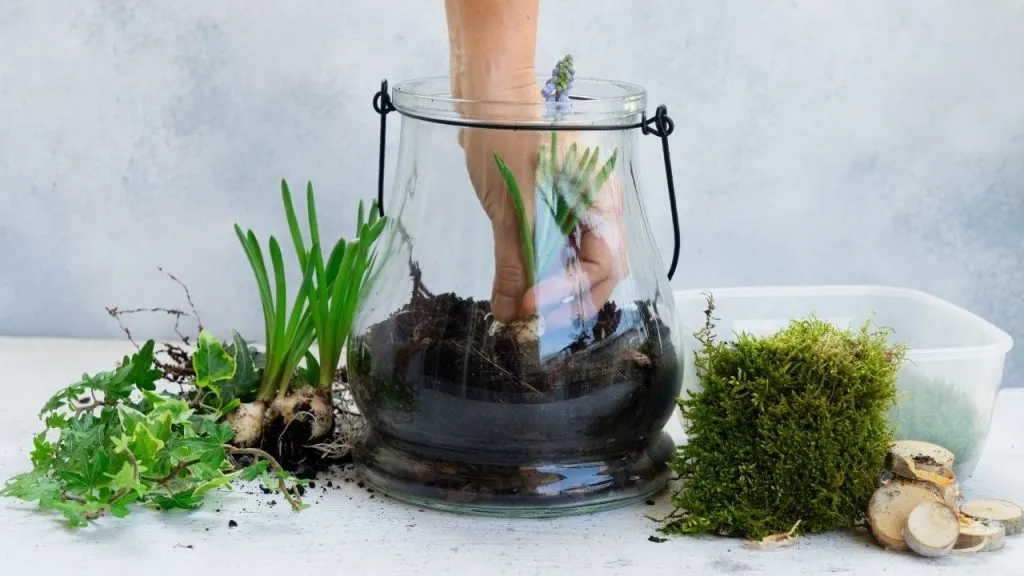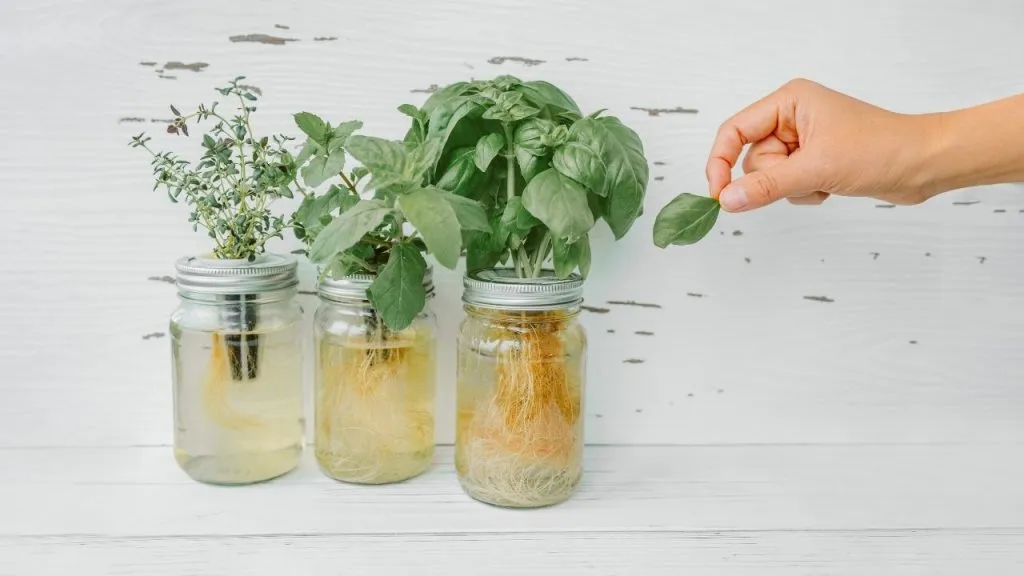Do you know Growing Mason Jar Hydroponic Herb Garden is a new way of growing nutrients at your home? You’ve attempted to cultivate herbs or vegetable plants inside your kitchen, yet everything you get is insects and filth on your floor.
Cultivating hydroponic seedlings inside a jar is an alternate way for interior cultivation. There is no clutter with hydroponics because it does not utilize dirt!
There are numerous pricing ranges for hydroponic gardening systems available in the sale, however, using cheap canning jars provides a cost-effective solution.
A hydroponic mason jar planting may become an integral element of your kitchen layout with some imagination.

Apart from their original usage, there are certainly a thousand and one alternatives to using your Mason jar. Hydroponics using Mason jars and Rockwool is a practical method to grow herbs inside.
Mason jars are widely used for food preservation and packaging. Develop your Mason jar hydroponic plant garden to repurpose these jars.
Throughout this post, we’ll go over a step-by-step approach to setting up your mason jar hydroponics setup and producing your fresh vegetables.
- Selecting Your Hydroponics Container; Mason Jar
- Hydroponics Supplies For A Mason Jar
- Selecting Net or Mesh Pot
- Selecting Mason Jar Hydroponic Nutrients
- Picking Your Mason Jar Hydroponics Vegetable
- Selecting A Growth Medium
- Finding A Source Of Light
- Setting Up Your Mason Jar Hydroponics System
- Why Are Mason Jars Used In Hydroponics?
- Kratky Hydroponics Inside A Mason Jar
- Mason Jar Hydroponics’ Advantages
- Mason Jar Hydroponics’ Drawbacks
- What Is The Budget For Making A Personal Hydroponic Mason Jar?
Selecting Your Hydroponics Container; Mason Jar
Choosing a mason jar is a smart choice for a multitude of purposes. The first is that they are frequently in the shape of sauce or vinegar jars, which you would purchase as part of your supplies.
You don’t have to purchase a special container specifically for planting. That’s a lot of cash conserved.
Furthermore, cultivating seedlings inside a mason jar is ideal since it does not leach any dangerous substances into the water and ground.
- Use the larger ones if possible. One significant benefit is that it would retain more water, eliminating the need to replenish it regularly.
- Notwithstanding its benefits, there is one drawback to mason jars. They are often translucent, allowing light to pass across.
- This may encourage algae development inside the water inside your jar. Not merely will such algae consume the minerals inside the water, but they will also spread out of control.
- You must paint your jar black to prevent all of this difficulty. This will prevent lighting from passing through into the container.
Growing Mason Jar Hydroponic Herb Garden- Setting Up System
Since you’ve gathered all the individual bits, it’s time to put the mason jar farm together!
A couple of tasks must be done a couple of days before setting up your hydroponic jar: immerse the Rockwool, immerse the Hydroton, plus proliferate the seeds.

1. Place The Seed Into The Rockwool
If you’re starting your plants from seed, place them inside the Rockwool. Allow it to sprout on the side. It is suitable for the following phase after it develops into a seedling.
2. Rockwool Should Be Soaked
Because of the production method, Rockwool is alkaline. Alkaline conditions are often unsuitable for plant development. Immerse it under an acidic medium till the pH level hits about 5.5.
A pH meter could be used to examine. You may get the liquid acidic by combining distilled water and lemon juice.
Immerse the Rockwool under water lasting 24 hours after the pH has reached the desired level.
3. Hydroton Should Be Soaked
You may do that once you begin to immerse the Rockwool. Immerse the Hydroton lasting 24 hours underwater. This would gather the extra water required by your seedlings to flourish.
Although this would render your Hydroton bulkier, your seedling will be able to draw moisture from those clay pebbles without any additional effort!
4. Your Mason Jar Should Be Painted
Apply many coats to your hydroponic jar to ensure that it is thick properly. Many coated would be required. Allow it to dry then place it underneath a light. Check if you could somehow find any lighting streaming inside.
As needed, apply an extra coating. Allow it to dry properly afterward. After that, sanitize it using hot water.
5. Make Slits In Your Yogurt Container
Rather than putting perforations in your yogurt cup, cut a few pieces off of it. Slits will keep the Rockwool in place meanwhile enabling the roots to spread freely.
You may carefully clip the slits out using a pocket knife. After that, immerse it under heated water to sanitize it.
6. Combine Your Hydroponic Fertilizers
Having received the appropriate advice from your neighborhood expert on which fertilizer liquid to employ, you must now combine it plus the appropriate volume of water.
Place your net cup inside. Fill your mason jar halfway with hydroponic mix fluids, approximately 1/2 inch over the bottom of the net cup. If your net cup is completely buried in the nutrition fluid, your sprouts may drown.
7. Place Your Sprout Inside A Mason Jar
In the bottom of your net cup, spread a coating of Hydroton. Next, introduce the Rockwool also with the developed sprout.
You may need to trim the Rockwool to a form that fits inside your net cup. Carefully add additional Hydroton over atop of the Rockwool.
Ensure it completely fits the top such that no sunshine may enter the jar via the topmost gap.
8. Set Your Mason Jar Under The Sunshine
This step is essentially the final phase. Permit it to develop by exposing it to sunshine. Every two weeks assess the water content inside your 1-liter mason jar.
Using a wooden stick, push well all completely to the bottom of your jar. Lift it again to assess the jar’s water content.
You may use a highlighter to trace the outside of your mason jar level towards the bottom of your net cup. This allows you to match the water condition with the stick more easily. Replenish as needed.
Hydroponics Supplies For A Mason Jar
With complement to your Mason jar, you would require other materials. Mason jar hydroponics, on the other hand, requires only a few supplies.

- The materials are reasonably priced and may be obtained from hydroponic equipment shops and the web. You’ll need these basic supplies:
- Mason jars: Varying sizes of Mason jars are obtainable. The dimensions of your Mason jar would be determined by the crop you intend to cultivate. Vary according to the extent of the Mason jar hydroponic plant garden, you may need many jars.
- Net Pots: Every Mason jar will necessitate a net pot. These net pots would be used to keep both Hydroton clay pebbles as well as Rockwool in position.
- Rockwool cubes: Crops are grown directly using water with Mason Jar Hydroponics. As a result, it is critical to choose a media that would provide structural assistance to your seedlings. Plants are physically supported by Rockwool growth cubes.
- Hydroton clay pebbles: Hydroton clay pebbles soak up a lot of water and then store it for subsequent usage. The stones will keep extra moisture away from the root systems.
- Hydroponic nutrients: To offer the minerals that your plants demand, combine a fertilizer mix with the water.
- Seeds: Hydroponic vegetable seeds are what you need to cultivate inside your Mason jar.
Selecting Net or Mesh Pot
A net pot often referred to simply as a mesh pot, would be a container with perforations on its bottom.
This is utilized to keep the growth media while also allowing the nutritional mixture to seep in and out. As time passes, young vegetable root systems will sprout out of those perforations.
Recycle Yogurt Cups
You may utilize yogurt cones, ice cream bowls, or even sour cream containers as your net pot. You must also ensure that it fits perfectly into your mason jar.
When it doesn’t, you may need to make some little adjustments to the net pot before actually placing it inside the jar.
Purchase Net Pots
By purchasing net pots at a retail shop, you may save the headache of estimating your yogurt cups.
It’s not expensive, and it is a great purchase if you want to make additional mason jar hydroponics. The sole consideration is the diameter. Check that it matches your mason jar.
Selecting Mason Jar Hydroponic Nutrients
The soil provides nourishment to the crops. Because there is no soil with hydroponics, your crop must obtain its nourishment from an alternate supplier – hydroponic fertilizers.
Every crop requires a varied proportion of minerals and also sunshine, based on whatever you intend to cultivate.
There’s an 8-15-36 nutrient for lettuce, which would be thoroughly blended to get the proper proportions of nitrogen, calcium, potassium, plus phosphorus for healthy growth.
It is essential to get guidance from a professional gardener when selecting the proper nutrient solution for a particular mason jar vegetable that you intend to cultivate.
There is a lot of variety out there, which might be overwhelming for beginners.
Picking Your Mason Jar Hydroponics Vegetable
- Choose lettuce, spinach, or basil if you’re a rookie. These develop swiftly and are often simpler to handle. A standard mason jar hydroponic setup will suffice to meet their requirements.
- When you’re cultivating large plants, such as tomatoes, a bigger arrangement using a wider mason jar may be required.
- There is a distinction between cultivating veggies from leftovers and seeds. Cultivating veggies from leftovers will not provide huge lush greens like seeds. Although seeds need lengthier to develop, they generate a greater amount of product.
- According to the cultivar, it might require close to 100 days before the lettuce to reach maturity and also be suitable for collection.
- Crisphead as well as Romaine lettuces reach maturity the slowest. Other types can be picked at any point during their blooming season.
- Basil matures in roughly 75 days. It requires nearly 45 days before spinach fully develops.
Selecting A Growth Medium
The fluid wherein your veggie develops is known as the growth medium.
It serves as a substitute for soil, offering basic support for your crop, enabling the root systems to develop, and feeding the root systems with minerals, oxygen, and moisture.
Selecting a medium might be daunting for novices. Here are a few examples:
- Hydroton
- Coconut fiber
- Floral foam
- Oasis cube
- Rockwool
- Perlite
- Grow stones
With the mason jar hydroponics, users may utilize Hydroton, which is among the top preferred alternatives for a range of factors, as well as Rockwool.
Hydroton is a type of porous stone that absorbs wetness, including hydroponic fertilizers.
They have pores that let air circulate throughout your vegetable. They can also be reused for an extended length of duration.
Rockwool is a cube-shaped natural fiber made from natural materials. They have an incredible ability to store moisture and oxygenate growing seeds or roots of vegetable waste. You may combine Hydroton with Rockwool.
Finding A Source Of Light
Crops require light to flourish. Positioning them beside your window to absorb the beams of the sun is likely the ideal option. Unfortunately, not everyone has sunlight streaming through their window panes.
It’s occasionally a matter of the home’s orientation or being obstructed by another high structure.
Under this instance, you may need to purchase an additional mason jar grow light. You may cultivate a wide range of vegetables all year long with these lighting systems!
They are intended to serve as the sun, supplying your seedlings with the array of lighting they require to develop.
Selecting suitable lighting to cultivate is a creative work in and of itself. It’s wise to acquire some suggestions from your neighborhood retailer.
In general, one must have their plant’s grow lights running for approximately 12 to 16 hours. Your plant’s regular development cycle requires additional 8 hours of darkness.
Switch it on whenever you wake up after a nap then switch it off whilst going to bed. Your plant requires as much natural light plus shade as available.
Why Are Mason Jars Used In Hydroponics?
Mason’s vessels are not only inexpensive and simple to acquire, but they often seem to offer an attractive appearance.
A series of jars along any window ledge having lovely green herbs blooming within may be a great complement to your house decoration.
Kratky Hydroponics Inside A Mason Jar
Novice hydroponic planters will benefit from Kratky hydroponics. These are simple to manufacture, long-lasting, and inexpensive.
They are an excellent way to determine your suitability for Mason jar hydroponics.
A non-circulating hydroponic farming approach is the Kratky method. There is no need for power, compressors, or air filters in this method.
With the Kratky technique, just the extremities of the roots make contact with the water. As the crop grows, its roots drain the reservoir’s freshwater supply.
There will be an air pocket inside the jar as a result of the procedure. Your crops will benefit from this air by developing oxygenated roots. This method’s goal is for your crop to run short on the water whenever it’s suitable for picking.
Mason Jar Hydroponics Advantages
- It is straightforward and just takes a couple of variables.
- Mason jar hydroponics takes very minimal room.
- It’s indeed ideal for those who are new to hydroponic farming.
- Appropriate for all seasons and climatic conditions.
Mason Jar Hydroponics’ Drawbacks
- Huge plants are not recommended.
- Not suitable for vegetation that demands water to be drained.
What Is The Budget For Making A Personal Hydroponic Mason Jar?
It all relies on whatever you possess on hand and whether you’re prepared to buy jars at thrift stores.
Should you purchase everything fresh, such as seeds, polyethylene baggies, the grow light, and so on, it may cost $50 maybe more.
However, if you simply require a few items, such as fertilizers plus Rockwool, but do not want an extra source of light, it might easily cost around $30.
When you’ve gathered all of the necessary materials, you may assemble additional hydroponic mason containers for subsequent hydroponic farming endeavors.
Growing Mason Jar Hydroponic Herb Garden FAQS
Q: Inside A Mason Jar, Could You Develop Lettuce?
Definitely. Leaf lettuce, in particular, possesses a shallow root system. That renders cultivating lettuce inside one mason jar not simply feasible but also worthwhile.
Q: What Should You Do If Crop Roots Grow Extremely Big?
Once the roots are cramped, this might be time to relocate your crop.
Q: Will Water Be Required?
This technique normally requires at minimum 1 gallon of water for every crop.
Conclusion
Growing Mason Jar Hydroponic Herb Garden has always been a simple technique to learn. It allows you to put your toes in and see if hydroponic farming would be for you.
And do not be scared to get started on the Mason jar hydroponic vegetables planting straight away by following the easy instructions and techniques outlined above.

My name is Olivia, and I live in the United States and love having plants in my garden. Lots of plants are there on my balcony, indoor and outdoor garden also. Here I am trying to share useful gardening tips, how to grow and care for various plants, etc.
